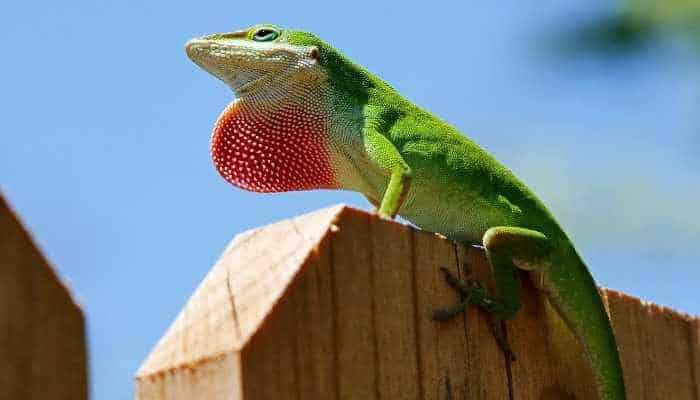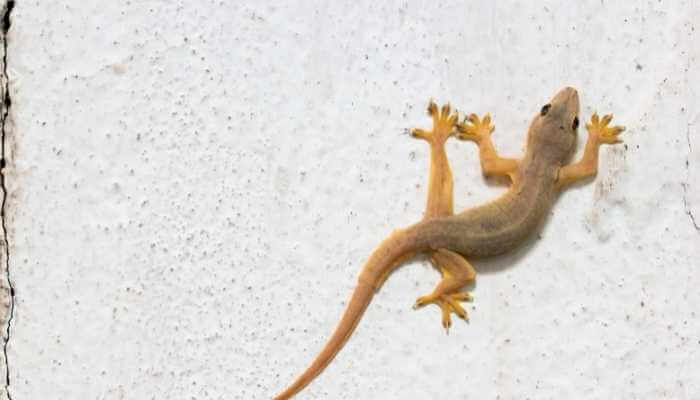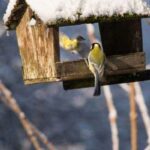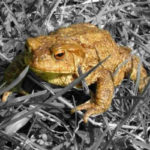You’ve seen them – scurrying up the back wall of your house, making you jump while weeding your garden, or sunning on the patio while you drink your afternoon tea. Every region has its own bunch of lizards, and I’ve seen bunches of them over my lifetime. But, I’ve always wondered, are they beneficial or harmful to your gardens and backyard?
Yard lizards are predators that take care of pests like rodents, insects (including grasshoppers and roaches), spiders, slugs, snails, and even small snakes. They are also non-poisonous. So they are very beneficial to your outdoor living space and help prevent infestations of indoor living spaces.
I thought it best to not only cover what lizards eat but also give you some information about the most common garden lizards that can be found in the United States. So let’s get to it!
Green Anole

Anoles are definitely predators. They only notice prey that moves. So you don’t have to worry about your plants or fruits with them. They can get to be 5 to 8 inches (12 – 20 cm) in length and despite the name, they actually change colors based on their mood, the weather, or their activity.
These are the lizards with the red or pink throat dewlap that they raise like a flag during territorial fights or to entice a mate. They can live anywhere from 3 to 8 years depending on whether they are in the wild or being kept as a pet.
They love being up high in tree branches or on human-made items that they can climb. But they love high humidity so swamp trees and forests in humid areas are the perfect territories for them. They’re wild little characters to have in your outdoor living space and garden and are very beneficial as they take out pests.
They prefer to eat insects such as flies and crickets but have been known to eat other types of insects when available.
House Gecko

These little lizards are the cutest, in my opinion. They have those knobby-toed feet that hold on better to slick surfaces, they have big eyes with unmoveable eyelids, and they actually make great pets. There are at least 24 distinct kinds of gecko living in the United States.
Geckos have the ability to morph their coloring for camouflage between a pale color and dark shades of brown. They’re really small, only growing to 1.5 – 2.5 inches (3.8 – 5 cm) in length. I can say from experience that these little guys can get into everything. I found one in my car’s glove box. So be aware.
Most of our geckos are Mediterranean House Geckos – an import that has taken over their ecosystem. They are nocturnal and urbanized, so you can find them more readily in the dark both inside and outside of a house. Though they like to live in crevices, they come out especially when there’s a light on at night to hunt insects.
These guys will click for attracting a mate and squeak when they feel threatened. They are usually also not afraid of humans. All of these traits make them happy helpers for your outdoor space. Some species do get a little larger, but most in the U.S. are not much larger than 3 inches.
They primarily like to eat insects like spiders, roaches, ants, and moths to name a few but are opportunistic feeders if other small insects are present.
Fence Lizards

Fence lizards come in a wide variety, usually denoted by the region from which they come (northern, eastern, western, southern). They often are a bit spiny and are usually a lovely gray-brown, brown, and darker brown with a pattern on their backs. They love rock piles, woodpiles, rotting logs, forested areas, and I’ve seen them popping beneath the edging of my siding.
The males, during summer mating season, will have the color blue or green on their bellies, chest, throats, and sometimes backs. They also perform for their females and to intimidate other males. I’ve seen head bobbing and push-ups!
According to the National Science Foundation, the only caution about these lizards is that they can carry ticks, which in turn might carry Lyme disease. Or at least the western fence lizard does (California Region). The eastern version has an extremely low prevalence of this.
The Fence Lizard diet consists of insects such as grasshoppers, worms, aphids, and ladybugs. They will definitely eat other types of small insects if the opportunity arises.
Skinks, Skinks, and more Skinks

There are over 1500 kinds of skinks in this world. The ones I see most often are the blue-tailed skink and the five-lined skink. Most of them get no longer than 8 in (20 cm). Most are very sleek of body, usually with long stripes running the length of their back and short legs (or no legs).
They can drop their tail, leaving it wiggling to catch the eyes of a predator while it escapes. Don’t worry, they can regrow it. They love leaf mulch and sunning in the garden. I usually see them sunning on my patio and driveway.
You can find them munching on a variety of pests including roaches, grasshoppers, worms, and snails.
Glass Lizards

Glass lizards are a special kind of creature. They don’t have any legs, so they essentially look like thin snakes. Unlike snakes, they can’t adjust their mouths and they have eyelids. Glass lizards can range in size from 18 – 43 in (46 – 108 cm).
I’ve found several of these in my gardens over the years. They love pine forests and the southern coastal plains of the US. Since that’s the region I’ve lived in most of my life, it stands to reason that I’d run across them.
They love sandy soil and can even be found in the dunes near the beach. They love to hide under boards or debris.
Some of their favorite insect meals are spiders and snails but have also been known to snack on beetles, caterpillars, and scorpions to name a few.
In Conclusion
As you can see, none of these lizards are poisonous, and all of them are helpful in keeping your garden free of small pests. They might get in the way now and again, but having them around your gardens and backyard space can be beneficial.
I’ve found very few lizards that will eat leafy vegetables, flowers, and berries, but they are rare in the United States. Iguanas, for instance, were brought over by the pet trade. They will strip a garden. These lizards are invasive and not normally found in any ecosystems beyond Florida.
If you want to encourage your beneficial lizards, leave some items untouched and be careful when raking through leaves and moving any stones or wood in the backyard, so as not to disturb the lizards or their eggs.
Also, if you have bowls of water out and about for the pets always place a stick in those, just in case a lizard needs a way out. Lizards get thirsty, too!
Because there are so many good creatures, like lizards, in the backyard, I avoid the use of pesticides. If you poison a pest, that poison can also harm the beneficial members of your backyard ecosystem.
I think they’re adorable, but not everyone does. Hopefully, no one in your family has a phobia of lizards, so you can thrive side by side in your outdoor living space.
If you are worried about a larger variety of pesky invaders that graze or burrow in your garden then be sure to check out my article on how to protect your garden from animals.













